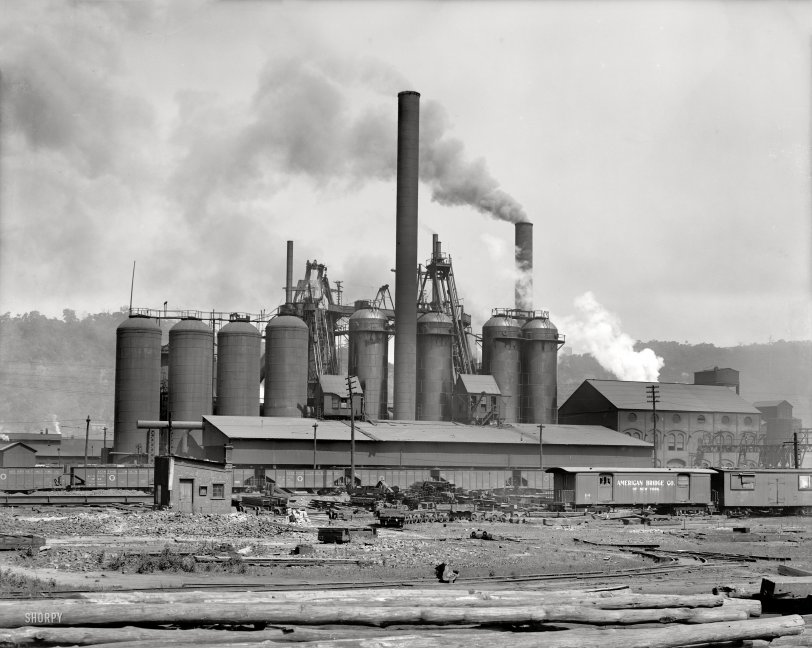


Framed or unframed, desk size to sofa size, printed by us in Arizona and Alabama since 2007. Explore now.
Shorpy is funded by you. Patreon contributors get an ad-free experience.
Learn more.

- Baldwin 62303
- Baldwin VO-1000
- Cold
- No expense spared
- Tough Guys
- Lost in Toyland
- And without gloves
- If I were a blindfolded time traveler
- Smoke Consumer Also Cooks
- Oh that stove!
- Possibly still there?
- What?!?
- $100 Reward
- Freeze Frame
- Texas Flyer wanted
- Just a Year Too Soon
- WWII -- Replacing men with women at the railroad crossing.
- Yes, Icing
- You kids drive me nuts!
- NOT An Easy Job
- I wonder
- Just add window boxes
- Icing Platform?
- Indiana Harbor Belt abides
- Freezing haze
- Corrections (for those who care)
- C&NW at Nelson
- Fallen Flags
- A dangerous job made worse
- Water Stop
Print Emporium
Here's Lucy: 1908

Pittsburgh circa 1908. "Carnegie Steel Company, 'Lucy' furnace." 8x10 inch dry plate glass negative, Detroit Publishing Company. View full size.
Where was Pittsburgh, anyhow?
The Lucy Furnace was named in honor of Andrew Carnegie's sister-in-law, Lucy Carnegie. Located on the Allegheny River at 51st St, it was dismantled in 1937.
The Romance of Steel, 1907.
By Herbert N. CassonThe Rise of Andrew Carnegie
… In 1873 two new furnaces had been built, now famous in the iron world as the Lucy and the Isabella. The Lucy belonged to the Carnegie company, and the Isabella to a combine of Pittsburgh iron men. These furnaces were of equal size, and belonged to rival owners. They began at once to race in the production of iron, and their amazing achievements for the first time attracted the attention of all countries to Pittsburgh.
The average output of a furnace was then fifty tons a day. There were wild hurrahs at the Carnegie company's works in 1874, when, for the first time in the history of ironmaking, the Lucy turned out a hundred tons of iron in one day. In England the news was received in silent incredulity. To believe that a single furnace could pour out twenty-two thousand dollars' worth of iron in a week was too much. Where was Pittsburgh, anyhow? And who was this Carnegie who made such preposterous claims? …
A second Lucy furnace was built in 1877, and the Carnegie company operated both until the organisation of the Steel Trust. During that period of nearly thirty years they produced more than three million tons of iron—enough to give four pounds apiece to every man, woman, and child on the globe; enough to pave a road seventy feet wide with iron plates an inch thick from New York to St. Louis. …
There is nothing idyllic about the Lucy furnaces. They have received no honours, no medals, no monuments. They have inspired neither artist nor poet. Yet for thirty-three years, for every hour of the day and night, they have been untiringly making the useless into the useful, magically transforming the ore into a ceaseless stream of that metal which is immeasurably more precious to civilisation than all the gold and silver and rubies and diamonds.
The tradition at U.S. Steel
The tradition at U.S. Steel is to name furnaces after wives of the President/Chairman. Lucy Coleman Carnegie was wife of Thomas M. Carnegie.
Recycle 1908 style
That is a very up-to-date string of coal cars in the background. All steel cars show Keystone Coal to be a very modern operation.
In the foreground is several stretches of disconnected narrow gauge plant track, with a string of cars and wheelsets nearby. These plantracks would change location quickly, as needed.
But what really interests me is that arch-roof former baggage car lettered American Bridge of NY. That car could easily be forty years old here.It likely was used by AB to carry rigging and supplies for their projects, although it may no longer be in use. To its right is a short ex reefer. [The hinged doors give away its former occupation. The windows cut into it indicate other uses by ABNY.] Its odd, double archbar trucks were popular on New York Central lines for a time.
Broken Windows
Well, I guess bridges shouldn't have windows, anyway.
























On Shorpy:
Today’s Top 5